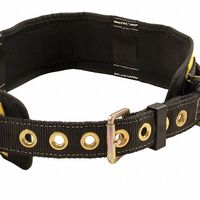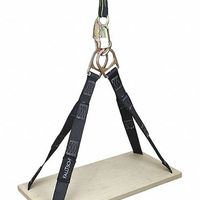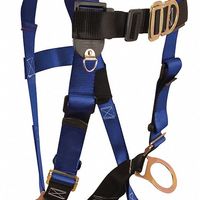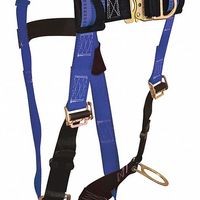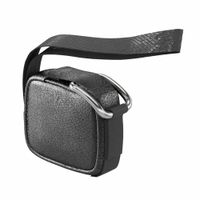Call +(254) 703 030 000 / 751 483 999 / 721 704 777
- Home
- Safety
- Fall Protection
- Fall Protection Harnesses Body Belts
.....Read More
Frequently Asked Questions
What is the proper way to fit a fall protection harness?
1. **Inspection**: Before fitting, inspect the harness for any damage, wear, or defects. Check buckles, straps, and stitching.
2. **Preparation**: Hold the harness by the dorsal D-ring (the metal ring on the back). Shake it to untangle the straps.
3. **Shoulder Straps**: Slip the harness over your shoulders like a jacket, ensuring the D-ring is centered between your shoulder blades.
4. **Leg Straps**: Pull the leg straps between your legs and connect them to the opposite ends. Ensure they are not twisted and adjust for a snug fit.
5. **Chest Strap**: Fasten the chest strap across your chest, approximately at mid-chest level. Adjust it to be snug but not restrictive.
6. **Adjustment**: Adjust the shoulder straps to ensure the D-ring remains centered on your back. The harness should fit snugly but allow full range of motion.
7. **Tightening**: Tighten all straps so the harness fits snugly against your body. You should be able to fit a flat hand between the strap and your body, but not a fist.
8. **Final Check**: Ensure all buckles are secure and straps are not twisted. The harness should be comfortable and allow for movement without slipping.
9. **Buddy Check**: If possible, have a colleague check the fit and security of your harness.
10. **Documentation**: Record the inspection and fitting in a log if required by your workplace safety protocols.
Proper fitting is crucial for safety and effectiveness in fall protection.
How often should fall protection harnesses be inspected?
Fall protection harnesses should be inspected before each use and undergo a formal inspection at least once a year. Daily inspections by the user are crucial to identify any visible damage, wear, or defects that could compromise safety. These inspections should include checking for frayed or cut webbing, damaged stitching, and ensuring all buckles and D-rings are functioning properly.
In addition to daily checks, a competent person should conduct a thorough inspection at least annually. This formal inspection should be more detailed, examining the harness for any signs of deterioration, chemical damage, or other issues that might not be immediately visible. The annual inspection should be documented, noting the condition of the harness and any actions taken.
If the harness is subjected to a fall or shows signs of damage during any inspection, it should be removed from service immediately and either repaired by a qualified professional or replaced. Regular inspections are essential to ensure the harness remains in good working condition and provides the necessary protection to prevent falls.
What are the different types of D-rings on a fall protection harness?
The different types of D-rings on a fall protection harness include:
1. **Back D-ring**: Located between the shoulder blades, this is the primary attachment point for fall arrest systems. It is used to connect to a lanyard or a self-retracting lifeline.
2. **Side D-rings**: Positioned on each side of the harness at the hip level, these are used for work positioning. They allow the wearer to work hands-free while being secured in place.
3. **Chest D-ring**: Found at the front of the harness, this D-ring is used for ladder climbing systems or rescue operations. It can also be used for positioning or travel restraint.
4. **Shoulder D-rings**: Located on the top of each shoulder, these are typically used for confined space entry and retrieval. They provide a secure point for lifting or lowering a worker vertically.
5. **Sternal D-ring**: Positioned at the sternum, this D-ring is used for climbing applications and can be an alternative to the back D-ring for certain fall arrest systems.
Each D-ring serves a specific purpose and is designed to meet different safety requirements and work scenarios. Proper use and attachment to the correct D-ring are crucial for ensuring safety and compliance with fall protection standards.
How do you choose the right fall protection harness for specific tasks?
Choosing the right fall protection harness involves several key considerations to ensure safety and compliance with regulations. First, assess the specific task and environment. Determine the type of work being performed, such as construction, roofing, or tower climbing, as each may require different harness features. Consider the fall distance and potential fall hazards to select a harness with appropriate fall arrest capabilities.
Next, evaluate the harness design. Full-body harnesses are generally recommended for most tasks as they distribute fall forces across the body. Look for features like padded shoulder straps, lumbar support, and quick-connect buckles for comfort and ease of use. Ensure the harness has the necessary attachment points, such as dorsal D-rings for fall arrest and front D-rings for climbing or positioning.
Check the harness material for durability and suitability for the work environment. For example, harnesses used in welding should be made of fire-resistant materials. Consider the weight and adjustability of the harness to ensure it fits the user properly, as an ill-fitting harness can compromise safety.
Verify compliance with relevant safety standards, such as ANSI Z359 in the United States or EN 361 in Europe. Ensure the harness is certified and regularly inspected for wear and damage.
Finally, consider the user's comfort and mobility. A comfortable harness encourages compliance and reduces fatigue. Involve workers in the selection process to ensure the harness meets their needs and preferences.
By carefully evaluating these factors, you can select a fall protection harness that provides optimal safety and functionality for specific tasks.
What are the regulations and standards for fall protection harnesses?
Regulations and standards for fall protection harnesses are primarily governed by organizations such as the Occupational Safety and Health Administration (OSHA) in the United States and the European Committee for Standardization (CEN) in Europe.
In the U.S., OSHA's regulations are outlined in 29 CFR 1910 for general industry and 29 CFR 1926 for construction. These regulations mandate that personal fall arrest systems, including harnesses, must be used when workers are exposed to fall hazards. The harnesses must be capable of withstanding a minimum tensile load of 5,000 pounds and should be inspected before each use for damage or wear.
The American National Standards Institute (ANSI) also provides standards, specifically ANSI/ASSE Z359, which covers the design, performance, and testing of fall protection equipment. This standard requires that harnesses distribute fall forces over the thighs, pelvis, waist, chest, and shoulders, and that they include a dorsal D-ring for attaching lanyards.
In Europe, the EN 361 standard specifies the requirements for full-body harnesses. It mandates that harnesses must be designed to hold the body securely and distribute fall forces evenly. The harnesses must be tested for strength, durability, and functionality under various conditions.
Both OSHA and CEN require regular inspection and maintenance of harnesses to ensure they remain in safe working condition. Training for workers on the proper use and fitting of harnesses is also a critical component of compliance with these regulations.
Overall, these regulations and standards are designed to ensure the safety and effectiveness of fall protection harnesses, minimizing the risk of injury or death from falls in the workplace.
How do you clean and maintain a fall protection harness?
To clean and maintain a fall protection harness, follow these steps:
1. **Inspection**: Before cleaning, inspect the harness for any signs of damage, wear, or defects. Check for frayed webbing, broken stitching, damaged hardware, and any other signs of wear.
2. **Cleaning**:
- **Materials Needed**: Use mild soap, warm water, and a soft brush or sponge. Avoid harsh chemicals, bleach, or abrasive materials.
- **Procedure**: Submerge the harness in warm, soapy water. Gently scrub the webbing and hardware with the brush or sponge to remove dirt and grime. Pay special attention to areas with visible dirt or stains.
- **Rinsing**: Thoroughly rinse the harness with clean water to remove all soap residues, which can degrade the material over time.
3. **Drying**:
- Hang the harness in a well-ventilated area away from direct sunlight and heat sources. Direct sunlight and high heat can weaken the webbing and other materials.
- Ensure the harness is completely dry before storing or using it again to prevent mold and mildew growth.
4. **Storage**:
- Store the harness in a cool, dry place away from direct sunlight, chemicals, and sharp objects. Use a designated storage bag or area to protect it from environmental damage.
5. **Regular Maintenance**:
- Conduct regular inspections before each use and perform a thorough inspection at least annually.
- Record maintenance and inspection activities in a log for reference and compliance with safety regulations.
6. **Replacement**:
- Replace the harness immediately if any damage is found during inspection or if it has been involved in a fall arrest event.
By following these steps, you ensure the longevity and safety of your fall protection harness.
What is the lifespan of a fall protection harness?
The lifespan of a fall protection harness is typically between 5 to 10 years from the date of first use, depending on the manufacturer's guidelines and the conditions under which it is used. However, this is a general estimate, and the actual lifespan can vary based on several factors, including the frequency of use, exposure to harsh environmental conditions, and the level of maintenance and care it receives.
Manufacturers often provide specific guidelines regarding the expected service life of their harnesses, and these should be followed closely. It is crucial to conduct regular inspections before each use and perform detailed inspections at least annually by a competent person. During these inspections, look for signs of wear and tear, such as fraying, cuts, abrasions, or any damage to the webbing, stitching, buckles, and D-rings.
Environmental factors such as exposure to sunlight, chemicals, extreme temperatures, and moisture can significantly affect the integrity of the harness materials, potentially reducing its lifespan. If a harness is subjected to a fall or shows any signs of damage or deterioration, it should be removed from service immediately, regardless of its age.
Proper storage and maintenance can help extend the life of a harness. Store it in a cool, dry place away from direct sunlight and chemicals. Clean it according to the manufacturer's instructions, typically using mild soap and water, and allow it to air dry.
Ultimately, the decision to retire a harness should be based on its condition and compliance with safety standards, rather than solely on its age. Always adhere to the manufacturer's recommendations and industry regulations to ensure safety and compliance.
